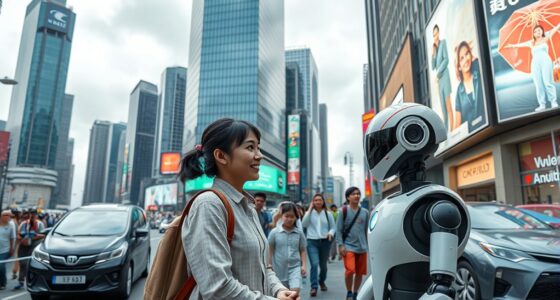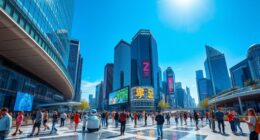In post-labor cities, urban planning shifts from focusing solely on job centers to supporting dispersed populations. You’ll need to contemplate expanding infrastructure, improving connectivity, and creating adaptable spaces that serve diverse needs. Planning must also foster resilient economies and inclusive communities, encouraging flexible industries and upskilling residents. If you explore further, you’ll discover innovative strategies to transform urban spaces beyond traditional employment hubs, shaping thriving, sustainable futures for evolving cities.
Key Takeaways
- Urban planning must prioritize adaptable infrastructure and land use to accommodate shifting population patterns beyond job proximity.
- Strategies should focus on enhancing connectivity, affordable housing, and mixed-use development to support diverse community needs.
- Governance needs to foster cross-sector collaboration and inclusive policies that address social equity amid changing employment landscapes.
- Data-driven approaches are essential to monitor demographic shifts, migration trends, and evolving workforce skills in post-labor cities.
- Emphasizing sustainability and resilience ensures cities can thrive despite declining reliance on jobs as primary anchors.
The Shift Away From Traditional Employment Hubs

Over the past decade, employment has increasingly shifted from traditional urban centers to suburban areas. You’ll notice that in the US, suburban employment growth outpaced urban core growth by 5.5 percentage points between 2007 and 2017—14.1% versus 9.4%. In nearly a third of metro areas, suburban jobs grew while urban employment declined; in others, both grew, but suburbs led. Only 20 metro areas saw urban growth exceeding suburban, yet many experienced job access declines despite growth. This shift contributed to a nationwide drop of 1.7 percentage points in the share of jobs accessible within a typical commute. The trend is especially marked in southwestern states, where job access shrank most, contrasting with some coastal metros that saw improvements despite urban growth. Technological advancements such as remote work tools and virtual collaboration platforms have also played a role in enabling this geographic shift in employment patterns.
Population Recovery and Its Impact on Urban Economies
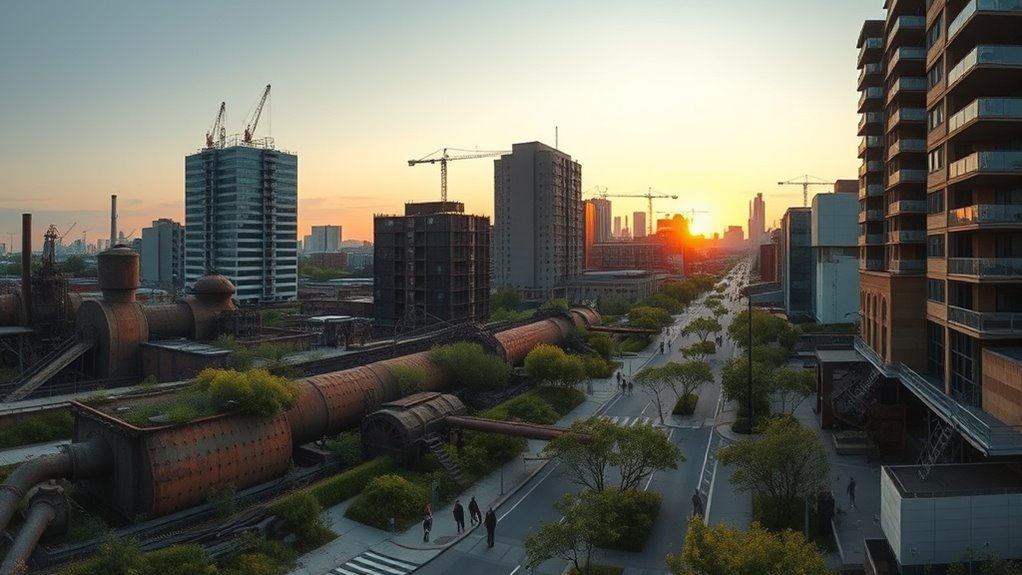
As urban populations recover, cities experience a surge in housing demand and economic activity. This growth boosts job opportunities, attracts new investment, and reshapes the workforce composition. Understanding these changes helps you see how post-labor cities are transforming their economies and communities. Recognizing the signs of emotional abuse can be vital for individuals navigating these societal shifts.
Population Growth Revives Cities
Population growth is breathing new life into many cities around the world, fueling economic revitalization and urban development. As more people move in, local economies expand through increased consumer spending, job creation, and infrastructure investments. Regions like North America and Latin America have high urbanization levels, with Asia housing the largest urban populations. Cities in the U.S., especially in the South and West, are experiencing notable growth, revitalizing their economies. This upward trend is driven by better opportunities, infrastructure, and services. To illustrate, here’s a quick comparison:
| Region | Urban Population Share | Key Drivers |
|---|---|---|
| North America | High | Economic opportunities, infrastructure |
| Asia | 54% of the world’s urban | Population growth in emerging economies |
This population revival reshapes city dynamics, fostering economic resilience and growth. Urbanization trends continue to influence how cities adapt to shifting populations and economic needs.
Housing Demand Surges
The surge in housing demand driven by population recovery is transforming urban economies, creating both opportunities and challenges. You face a housing market strained by a significant supply shortage, with estimates of a 2.5 to 5.5 million unit shortfall. Although new construction is authorized, high costs and interest rates slow progress. Existing inventories remain below pre-pandemic levels, fueling rapid sales and pushing prices upward. Cities like Knoxville and Phoenix see increased migration, boosting demand and home prices. Regional differences intensify: some areas experience rapid appreciation, while others face affordability issues. Urban planners must address these supply constraints through innovative solutions, zoning reforms, and infrastructure development, ensuring that rising housing needs support sustainable growth without exacerbating affordability problems. Additionally, integrating leadership skills into planning processes can enhance stakeholder collaboration and drive more effective policy implementation.
Workforce Composition Evolves
Urban labor markets are experiencing significant shifts driven by population recovery, which reshapes workforce composition and influences economic resilience. As populations rebound in post-industrial cities, the labor supply expands, supporting new economic activities and diversifying sectors. This growth helps balance previous job losses and reduces sector-specific vulnerabilities. However, migration patterns—both domestic and international—affect the size and skill mix of the workforce, though restrictive immigration policies can limit this effect. Demographic changes, such as an aging workforce retiring faster than replacements, create skill shortages, while increasing participation from women and underrepresented groups reshapes the labor landscape. Technological advances, including automation and remote work, further alter workforce needs, emphasizing adaptability, upskilling, and hybrid models to sustain urban economies amid ongoing demographic shifts. Incorporating adaptability into workforce strategies is essential for resilient urban development.
Rethinking Urban Data: Tracking Changes in Demographics and Labor Markets

Tracking demographic shifts and labor market changes requires rethinking traditional data approaches, especially as cities face aging populations and evolving workforce dynamics. You need to focus on new indicators that reflect these transformations. Consider these key points:
- Urban populations are aging, with fewer young workers and more seniors, influencing skill demands.
- Migration patterns diversify workforces but can cause skills mismatches.
- Education levels remain vital, correlating with employment and wages.
- Labor force participation stagnates around 62.5%, limiting growth potential.
- Employment rates stay steady, indicating a stable but non-expanding workforce.
- Incorporating changing skill requirements into urban data analysis is essential to adapt to these demographic and economic shifts.
Urban Land Growth and Its Spatial Consequences

As cities expand their footprints, land growth often outpaces population increases, leading to sprawling, fragmented landscapes with ecological impacts. You’ll notice that urban land expansion follows a synchronized, global pattern, with regions like Asia still only halfway urbanized, signaling future growth potential. North America and Latin America are more mature, with over 80% urban populations, shaping dense land use. As urban areas grow outward, edge expansion dominates, often replacing rural zones and increasing land consumption. This intensifies pressure on transportation infrastructure and raises land values, affecting affordability and social segregation. Emerging urban regions drive demand for real estate, pushing development into peri-urban areas. Lower interest rates could boost investment, further expanding urban footprints, while land growth reshapes how cities function, connect, and evolve spatially.
Challenges in Urban Planning for Post-Labor Cities

Post-labor cities face complex challenges in planning their futures, as they must balance economic renewal, social cohesion, and environmental resilience. You’ll need to foster economic diversification after traditional industries decline, avoiding stagnation and polarization. Addressing social inequality is *crucial*—widening income gaps and housing crises threaten community stability. Environmental vulnerabilities, like pollution and urban heat, demand integrated solutions that promote sustainability and health. Meanwhile, governance struggles with fragmented decision-making, limiting resource efficiency. You’ll have to navigate these hurdles by:
- Encouraging innovation sectors to replace lost jobs
- Promoting social equity through inclusive planning
- Addressing health risks from aging infrastructure
- Balancing environmental protection with growth
- Building stronger collaborations across sectors
These challenges require adaptive strategies, transparency, and bold leadership to guaranteeresilient, equitable post-labor cities.
Developing Infrastructure for Dispersed Populations
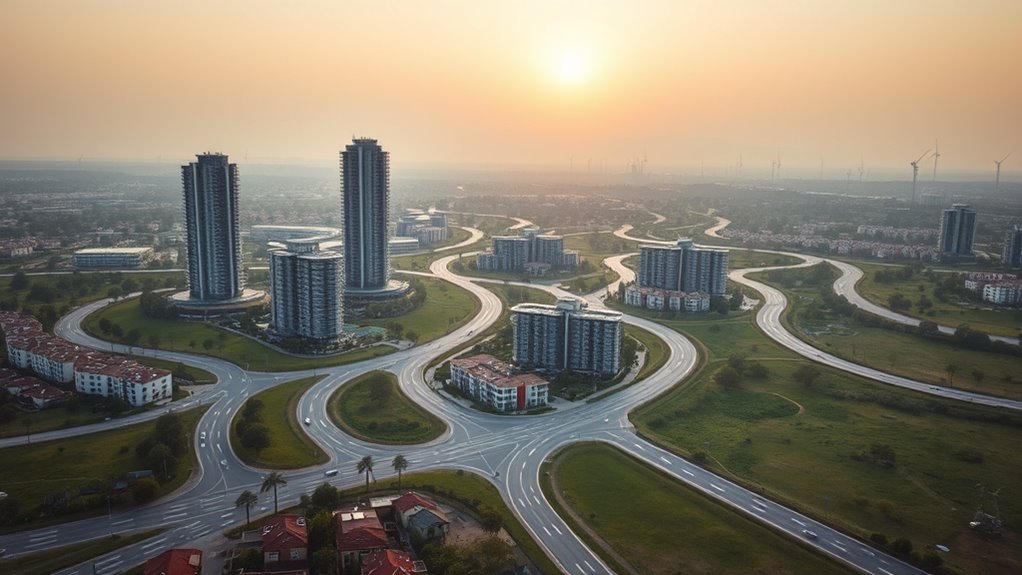
Developing infrastructure for dispersed populations presents unique challenges that require strategic planning and innovation. Urban areas benefit from lower costs and more efficient service delivery, but rural regions face higher expenses and environmental impacts when providing essentials like water, electricity, and sanitation. As urbanization continues, with over half the world’s population living in cities by 2050, planners must also consider smaller cities that offer economic opportunities. Improving rural-urban connectivity is key to supporting dispersed communities, enabling better resource sharing and access. Infrastructure must be adaptable to shifting population patterns, integrating advanced transportation systems and sustainable building practices. Efficient land use becomes critical, given that a small percentage of land is urbanized. Innovative planning can help balance cost, accessibility, and environmental sustainability across dispersed populations. Additionally, incorporating community engagement ensures that infrastructure development aligns with local needs and promotes long-term sustainability.
Fostering Resilient and Inclusive Urban Economies
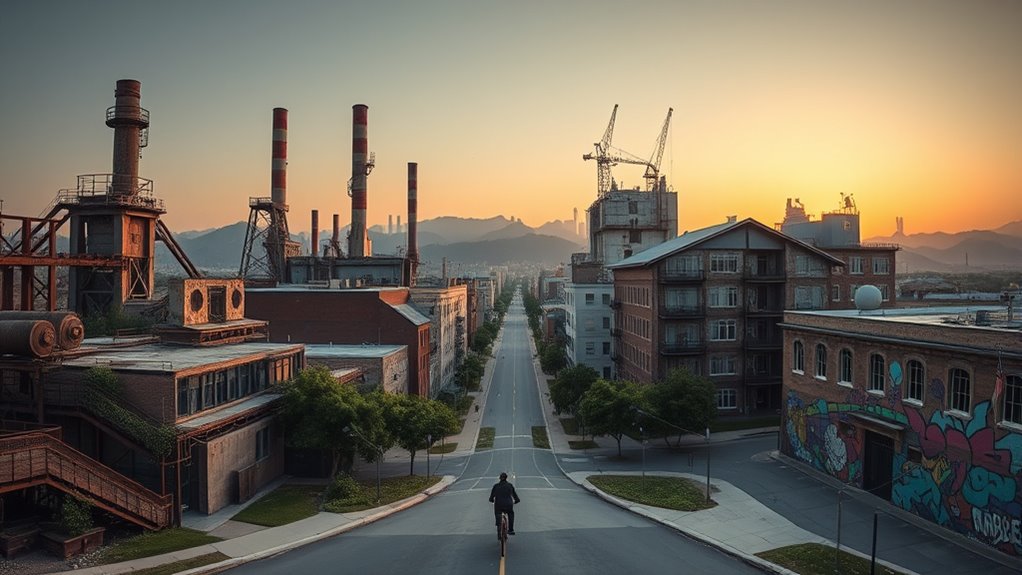
Building resilient and inclusive urban economies requires a strategic focus on diversification, workforce development, and community engagement. To achieve this, you should encourage a mix of industries like emerging tech, creative sectors, and green jobs, which balance job opportunities and reduce sector-specific vulnerability. Supporting small and medium enterprises boosts flexibility and adaptability. Investing in sectors less reliant on traditional labor, such as gig economy services and remote work platforms, sustains economic activity. Establishing innovation hubs stimulates entrepreneurship and attracts diverse businesses. Additionally, prioritize workforce programs that upskill marginalized groups, incorporate digital literacy, and promote lifelong learning. Engaging stakeholders—workers, employers, and communities—to inform policies is essential for fostering economic resilience. This approach guarantees economic resilience, builds inclusion, and prepares urban economies for a post-labor future.
Strategies for Adaptive Urban Development in a Labor-Decoupled Era
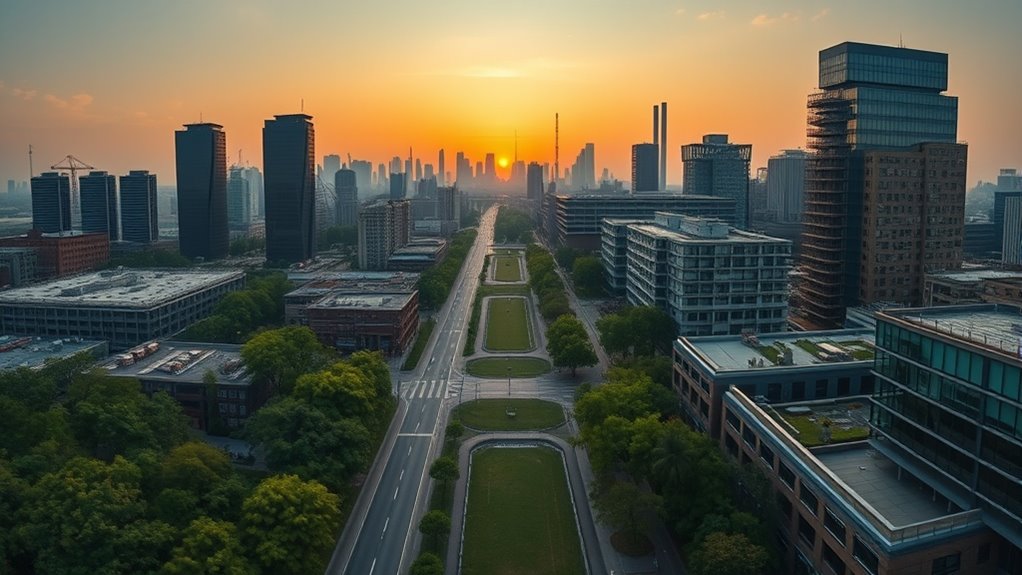
In a labor-decoupled era, cities must adopt adaptive development strategies that maximize the value of existing assets and address environmental challenges. Focus on repurposing infrastructure instead of new construction, boosting sustainability and reducing waste. Prioritize projects that benefit local communities, like affordable housing or communal spaces. Use low-carbon materials to lower the environmental footprint during conversions. Conduct whole-life carbon assessments to evaluate long-term impacts. Tailor policies to each city’s unique cultural, legal, and financial contexts for better results. Embrace green infrastructure such as green roofs, urban parks, and natural stormwater management systems to improve air quality, reduce heat, and support biodiversity. These strategies help cities become resilient, sustainable, and adaptable, ensuring they thrive in a future where jobs no longer anchor populations. Incorporating high-performance home theatre projectors can also enhance community spaces and foster social cohesion through shared entertainment experiences.
Frequently Asked Questions
How Will Cities Attract and Retain Residents Without Traditional Job Anchors?
You can attract and retain residents by focusing on quality of life, community, and innovation. Emphasize diverse amenities, cultural events, and green spaces that make your city appealing. Support entrepreneurship, improve infrastructure, and foster inclusive neighborhoods. Offer affordable housing and sustainable designs to create a vibrant, connected environment. By prioritizing these factors, you create a city where people want to stay, even without traditional job anchors.
What Role Does Technology Play in Shaping Post-Labor Urban Spaces?
Technology plays a essential role in shaping post-labor urban spaces by making cities smarter, more efficient, and inclusive. You can leverage IoT, AI, and data analytics to optimize resources, improve public services, and enhance safety. These innovations foster sustainable practices, create vibrant neighborhoods, and boost citizen engagement. By integrating technology thoughtfully, you help develop dynamic urban environments that prioritize quality of life and community wellbeing beyond traditional job centers.
How Can Urban Planners Address Housing Affordability Amid Population Growth?
You’re probably wondering how urban planners can tackle housing affordability as populations swell—like that’s an easy puzzle. Well, you could loosen land-use restrictions, promote mixed-use and inclusive zoning, and incentivize developers to build affordable homes. Embracing remote work can also spread demand out. It’s about collaborating across sectors and daring to think differently—because if not, we’ll all be stuck in overpriced, cramped cities, dreaming of better options.
What Policies Support Economic Diversity in Post-Labor City Models?
You can support economic diversity by implementing policies that promote sectoral diversification, like incentives for different industries and investing in infrastructure. Encourage occupational training and job matching services to build a versatile workforce. Develop mixed-use neighborhoods with accessible public transportation and affordable housing. These measures foster resilience, guarantee inclusive growth, and adapt to changing economic landscapes, helping your city thrive even when traditional jobs decline.
How Will Transportation Networks Evolve to Serve Dispersed Urban Populations?
You’ll find that transportation networks will evolve by becoming smarter and more connected, making it easier to get around dispersed areas. Expect expansion of transit options like on-demand shuttles, bike-sharing, and integrated digital systems that adapt to changing needs. These innovations help bridge gaps, so the city doesn’t become a case of out of sight, out of mind. Your mobility will become more flexible, ensuring everyone stays connected even as urban layouts change.
Conclusion
As you navigate these shifting urban landscapes, you’ll find that adapting to post-labor cities isn’t just about planning—it’s about embracing the unexpected. With populations redistributing and economies evolving, your strategies must reflect this complexity, turning coincidence into opportunity. By fostering resilience and inclusivity, you can shape cities that thrive beyond traditional jobs, proving that sometimes, the most profound change arises when you least expect it. In this new era, your vision becomes the catalyst for transformation.




